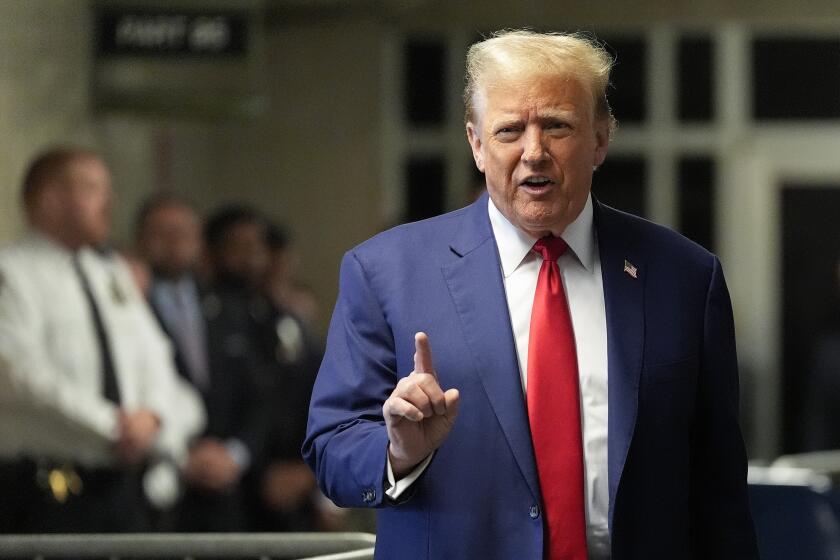A Case of Attention Budget Deficit Disorder in U.S.
In what seems like a long-ago era, way back in the Clinton administration, politicians of all stripes howled about the dangers of the federal budget deficit.
Today, however, few voice such concerns.
Deficit spending is seen as a tonic for the soft economy. President Bush has just offered a stimulus plan that foresees continued deficit spending -- to the tune of $150 billion a year -- for the balance of the decade.
“The government must run a deficit now to prevent rising unemployment and get the weak economy moving again,” says economist Barry Bosworth of the Brookings Institution in Washington. His is the conventional wisdom.
Yet here’s a prediction: Watch for mounting concern over deficits, a return of fierce political wrangling over the effect of federal red ink on business and the economy -- and, in what could prove a real blow for Wall Street and Main Street alike, for interest rates to rise should things not pan out the way the Bush administration is promising.
Indeed, though few are focused on it now, the troubled economy of the late 1980s and early ‘90s could foretell what the economy will look like at the end of this decade if those controlling the government’s purse strings aren’t careful -- and lucky.
The stakes are huge. The government will need a budget surplus in the next decade as a growing number of baby boomers retire and begin taking more out of the Social Security trust fund each year than is coming in from payroll taxes.
Back in Clinton’s day, the deficit was widely viewed as a drag on economic growth and business investment in the short run -- and a threat to bankrupt the economy in the long run.
Ross Perot called the deficit “a slow cancer” on the country and ran for president vowing to clean up the nation’s budgetary mess. Once they took the White House, Bill Clinton and his economic team -- Lloyd Bentsen and Robert E. Rubin in particular -- attacked the deficit with vigor. Republicans, unable to easily label the Democrats spendthrifts anymore, accused the Clintonites of stealing a page from their playbook.
The rich reward for all that fiscal responsibility: a surging economy and a soaring stock market through the late 1990s.
Without question, the situation that Bush faces today is starkly different from the one confronting Clinton when he first came into office. At that time, Washington was staring at “deficits of $300 billion a year as far as the eye could see” -- about 4.5% of the gross domestic product, notes Robert B. Reich, who served as Clinton’s secretary of Labor. And that made investors nervous, weighing down the stock and bond markets.
Vice President Dick Cheney, in a speech Friday to the U.S. Chamber of Commerce, pointed out that the deficit this year -- expected to hit $159 billion -- represents just 1.5% of GDP (the nation’s total output of goods and services).
That, he suggested, is a level that the government can handle, especially if it means brighter days ahead.
“Clearly acting now to promote growth and prevent even larger deficits in the future is the economically sensible thing to do,” he declared.
Even Reich, who resides at the far opposite end of the political spectrum from Cheney, agrees that the deficit poses no great danger today. “Deficits,” he says, “always have to be looked at as a percentage of the total economy.”
But there is a growing chorus of critics who aren’t so sanguine -- and they’re well worth listening to.
Robert Reischauer, who once headed the nonpartisan Congressional Budget Office, which makes long-term projections of federal finances, predicts that by the summer, the CBO will begin raising its deficit forecast significantly. He expects the figure to climb to $200 billion a year, hitting as much as $400 billion annually by 2012.
“We’re still in the afterglow of the sublime 1990s,” says Reischauer, who now is president of Washington’s Urban Institute. But he is skeptical that the Bush plan will be strong enough to counteract the deficits that it triggers. “I don’t think they can provide the growth” to offset the torrent of red ink.
Similarly worried is Alice Rivlin, Clinton’s head of the Office of Management and Budget and vice chair of the Federal Reserve Board in the 1990s. Rivlin, also now at Brookings, certainly understands the need for deficit spending in a tepid economy. “But people like me are getting nervous,” she says, that the deficit will swell out of control.
Far from the refined world of Washington think tanks, others also have concerns.
Bill Gross, managing director of Pacific Investment Management Co. in Newport Beach, sees even moderate budget deficits of 1% of GDP a year through this decade causing inflationary expectations and higher interest rates.
“It seems to me fairly obvious,” he said in a recent interview with CNBC, “that if you have a $600-billion increase in the budget deficit over 10 years -- and we’re expecting much more than that: $300 billion to $400 billion a year -- then there should be some pressure on the upside of interest rates.”
Adds another Wall Street veteran: “When the economy strengthens, if deficits continue, investors will demand higher interest rates on government borrowing, and that will retard the recovery and the place of the U.S. economy in the world.”
Which camp will prove correct -- the pessimists or the optimists -- won’t be known for years. But this much is certain: The battle over budget deficits that played out in the ‘90s is about to erupt again.
*
James Flanigan can be reached at jim.flanigan @latimes.com.
More to Read
Get the L.A. Times Politics newsletter
Deeply reported insights into legislation, politics and policy from Sacramento, Washington and beyond. In your inbox three times per week.
You may occasionally receive promotional content from the Los Angeles Times.






